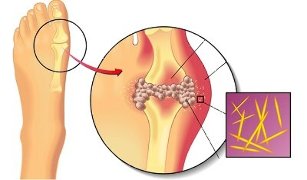
Gout is a disease associated with impaired purine base exchange. Leads to deposition of uric acid salts on joints and internal organs.
The main symptoms are recurrent attacks of acute arthritis, the formation of tofus (compaction focus) on the feet and earlobes. Therapy during the active period is medication, with the use of anti-inflammatory drugs.
To speed up the onset of remission and increase duration, patients are advised to adhere to certain dietary therapy principles. Properly selected diet for gout can significantly improve a patient's quality of life, reduce the number of disease attacks, and reduce the risk of irreversible damage to the kidneys, central nervous system, and musculoskeletal system.
Goals and principles of diet correction
The main goal of food nutrition in patients with gout is to reduce the concentration of uric acid complex in blood plasma. The product consumed by the patient should be selected so that no one contains more than 150 mg of purine per 100 g weight. The patient is shown in table 6.
Diet is most effective if the following principles are followed:
- Strict adherence to the rules until irreversible changes occur. It is impossible to remove conglomerates that have already formed in the joints and kidneys using gastronomic restrictions. The selected menu has preventative purposes, helping to prevent salt deposition.
- Dietary approach, taking into account the frequency of the crisis, the level of uric acid, the severity of the process. Beyond joy, the diet should contain reduced amounts of protein, fat, sodium salts. Alcohol should be completely eliminated. During the active period, strict restrictions are indicated: the food is frugal, mostly liquid.
- Weight correction. For obese people, the product is selected up to a total calorie content below the energy consumption level of 300-500 kcal per day. The patient's lifestyle and daily level of physical activity should be considered.
- No more than 200 mg of purine base per day. The figures shown are very important to the patient. A large number of uric acid compounds do not allow to maintain its levels in the body within acceptable limits.
In addition to the above, adherence to drinking rules is required. If there are no contraindications from the cardiovascular system, the patient should take about 2-2, 5 liters of fluid per day. Hydrocarbonate mineral water is recommended. This encourages alkaline internal environment, reducing acidity.
Nutrition during exacerbation
At the level of increased uric acid content in the blood and the recurrence of pathology, dietary restrictions are most noticeable. The daily amount of protein should be stored in 70 g, fat - 80 g, carbohydrates - 240 g. The caloric content of the diet is 1950-2000 kcal. Diet - four times a day, between you must drink fluids. Food temperature is normal, 55-60 ° C for hot dishes and 15 ° C for cold dishes. There is no need for targeted heat savings. It is better if the food consistency is liquid or soft.
The following foods are recommended:

- milk;
- lactic acid drinks;
- vegetable juice;
- citrus-based juices;
- liquid grains;
- grated fruit;
- roe ikan;
- tomato sauce.
If there is a clinical manifestation of this disease, a person should not eat food that is acceptable at the remission stage. You must reject solid dishes, pastries, meat and fish in any form, eggs, sweets, spices, oils. The need for animal protein is met exclusively by milk ingredients. Restrictions must be adhered to during the attack period. On average, this takes 5-7 days. Once the inflammatory process in the legs subsides, they gradually return to a normal diet. The intersection takes 2-3 days.
Nutrition in remission
Adhering to a gout diet is necessary even if there are no obvious symptoms. Restrictions in this case are not as strong as exacerbations. However, they must be strictly adhered to. The basic requirement is the complete elimination of meat from young animals, which contains the maximum amount of purines. Its concentration can reach 1000 mg per 100 g, which is much higher than the allowable value. Also, meat extracts, mackerel, sardines, beef liver (liver, kidney, brain), alcoholic beverages are contraindicated.
Table number 6 shows the consumption of 100 g of protein and fat, 450 g of carbohydrates per day. The overall nutritional value of the daily menu is 3200 kcal. The volume of liquid is 1, 5-2 liters, if this is not contrary to the treatment of other diseases a person suffers from.
The list of things a patient can do includes:
- kefir;
- fresh cabbage cabbage soup;
- porridge;
- omelet;
- roti rai;
- fruit jam;
- vegetable oil;
- lemon or orange;
- mashed potatoes;
- soufflé ikan;
- grain;
- eggs;
- cheese;
- meat diet in the amount of not more than 120 g per day.
Low levels of purine in products such as cereals, vegetables, honey, nuts, and tomatoes. They can be eaten without restrictions. Pork, beans, spinach, sorrel, mushrooms contain from 50 to 150 mg of ingredients, which should be taken into account when compiling the menu.
For weight loss
Weight loss is recommended for patients with hypersthenic and normosthenic physiology. The calorie content of the diet must be reduced to 30 calories per kilogram of body weight. It is important that weight loss occurs gradually, no more than one kilogram per month. This will ensure an acceptable level of ketone body formation. With the lack of nutritional value of the product, its synthesis exceeds the allowable limit. A low-calorie diet excludes or restricts the consumption of baked goods significantly.
Prohibited foods: breads, pies, pizzas, cakes, cheeses, pastries, sugar, sweets, sweet jams, preservatives, and more.
The table should be based on the components:
- low-fat cottage cheese;
- kefir;
- vegetables;
- fruits.
Weight management is not limited to low-calorie foods. Patients should lead an active lifestyle, engaging in physical education according to individually developed programs. Otherwise, dietary restrictions will be too strict, which will reduce a person’s adherence to therapy.
Sample menu for a week
Patients with gout should know exactly what not and what to eat. It is better if one clearly explains his diet for a relatively long period of time. Usually food is developed for a week. The existing scheme can be used for several months, after which the set of plates is changed or stirred daily. With high uric acid levels, the weekly diet may look like this.
Monday
- Breakfast # 1: casserole, coffee with milk.
- Breakfast # 2: baked apples.
- Lunch: vegetable soup, bread, rosehip broth.
- Afternoon snack: fruit jelly.
- Dinner: cabbage rolls, kefir.
Tuesday
- Breakfast # 1: cheese, tea, bread.
- Breakfast # 2: orange.
- Lunch: lean cabbage soup, bread, ingredients.
- Afternoon snack: buckwheat porridge.
- Dinner: kefir, carrots.
Wednesday
- Breakfast # 1: eggs, fruit juice.
- Breakfast # 2: marmalade, mineral water.
- Lunch: vegetable borscht, rye bread, tea.
- Afternoon snack: milk jelly.
- Dinner: dried fruit, jam.
Thursday
- Breakfast # 1: cucumber salad, rose hips.
- Breakfast # 2: orange pomace.
- Lunch: potato soup, fruit drinks.
- Afternoon snack: pear.
- Dinner: scrambled eggs, dried apricots, tea with lemon.
Friday
- Breakfast # 1: boiled beets, blueberry juice.
- Breakfast # 2: kefir.
- Lunch: pearl barley soup, tea.
- Afternoon snacks: milk, bread.
- Dinner: carrot slices.
Saturday
- Breakfast # 1: rice porridge, coffee.
- Breakfast # 2: watermelon.
- Lunch: soup, agar-agar milk.
- Afternoon snack: fresh cucumber.
- Dinner: kefir, bread.
Sunday

- Breakfast # 1: boiled eggs with sour cream and tea.
- Breakfast # 2: wine.
- Lunch: cabbage pieces, barley soup, juice.
- Afternoon snack: casserole.
- Dinner: pancakes, yogurt.
The diet provided is incomplete. Any component from the list of what is allowed to the patient can be added to it.
Care should be taken to ensure that the total caloric content of the food and the purine base content in it does not exceed the set limits.
Cooking methods
Dishes can be steamed or baked. This approach allows you to ensure the optimal taste of the product, while maintaining its useful nutrients. Foods processed in this way require a gentle regimen for patients with a diagnosis equivalent to a gastroenterological profile. Cooking is allowed, however, if the meat or fish is cooked this way, the broth is dried. The fact is that in the process of processing, about 50% of the purines contained in animal muscle fibers are transferred into it.
Proper nutrition is one of the main components of treatment for gout in the legs. A person who does not comply with the requirements needed to make a diet is more likely to suffer from relapses of the disease, even with adequately selected pharmacological therapy. Rejection of proper nutrition during exacerbations contributes to an increase in symptoms and an increase in the time required for recovery. The patient gets detailed information about what should not be and what to eat from the doctor treating him. Therefore, at the first signs of pathology, you should seek help from a specialist who will choose a diet and prescribe treatment.




























